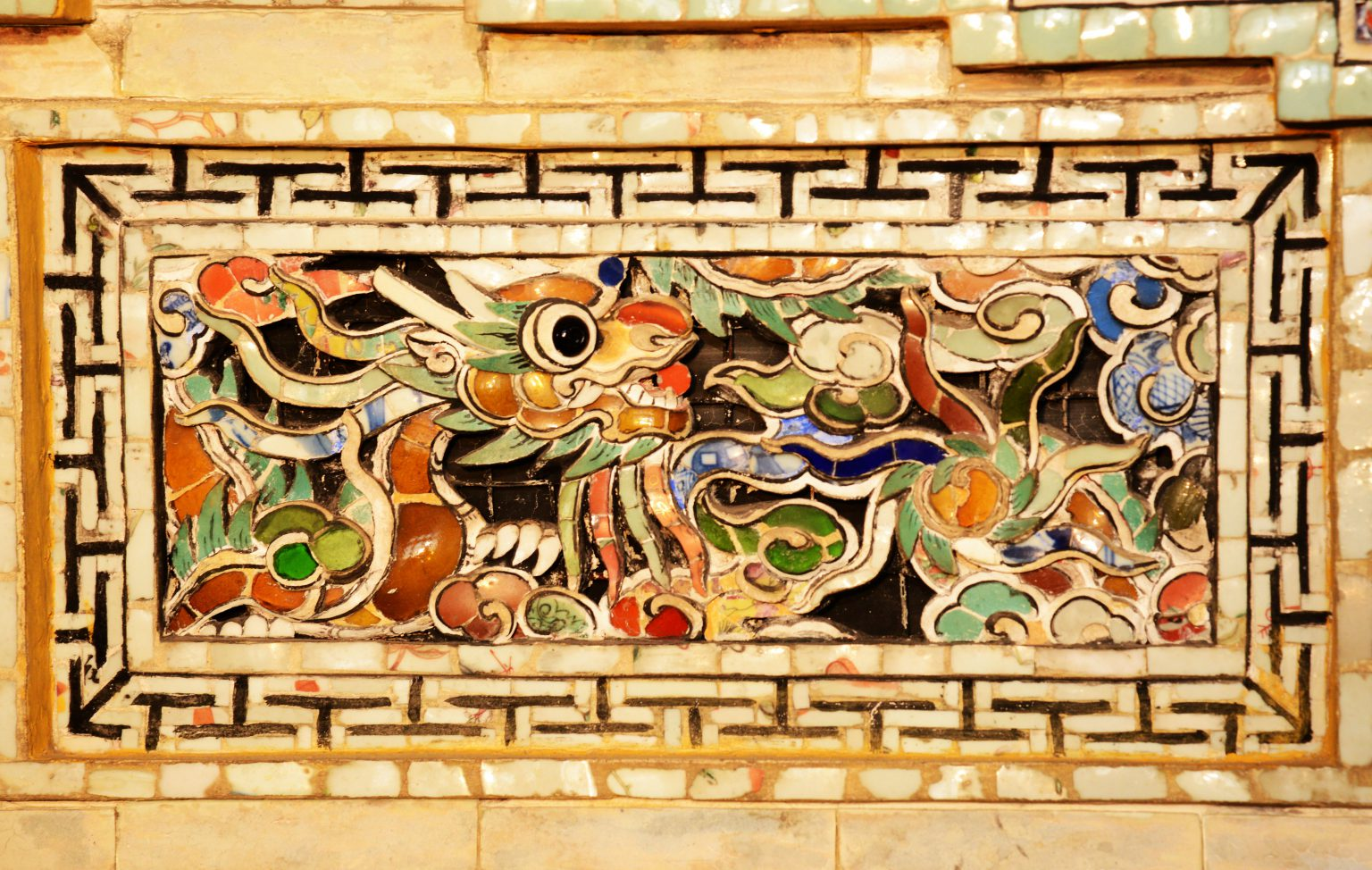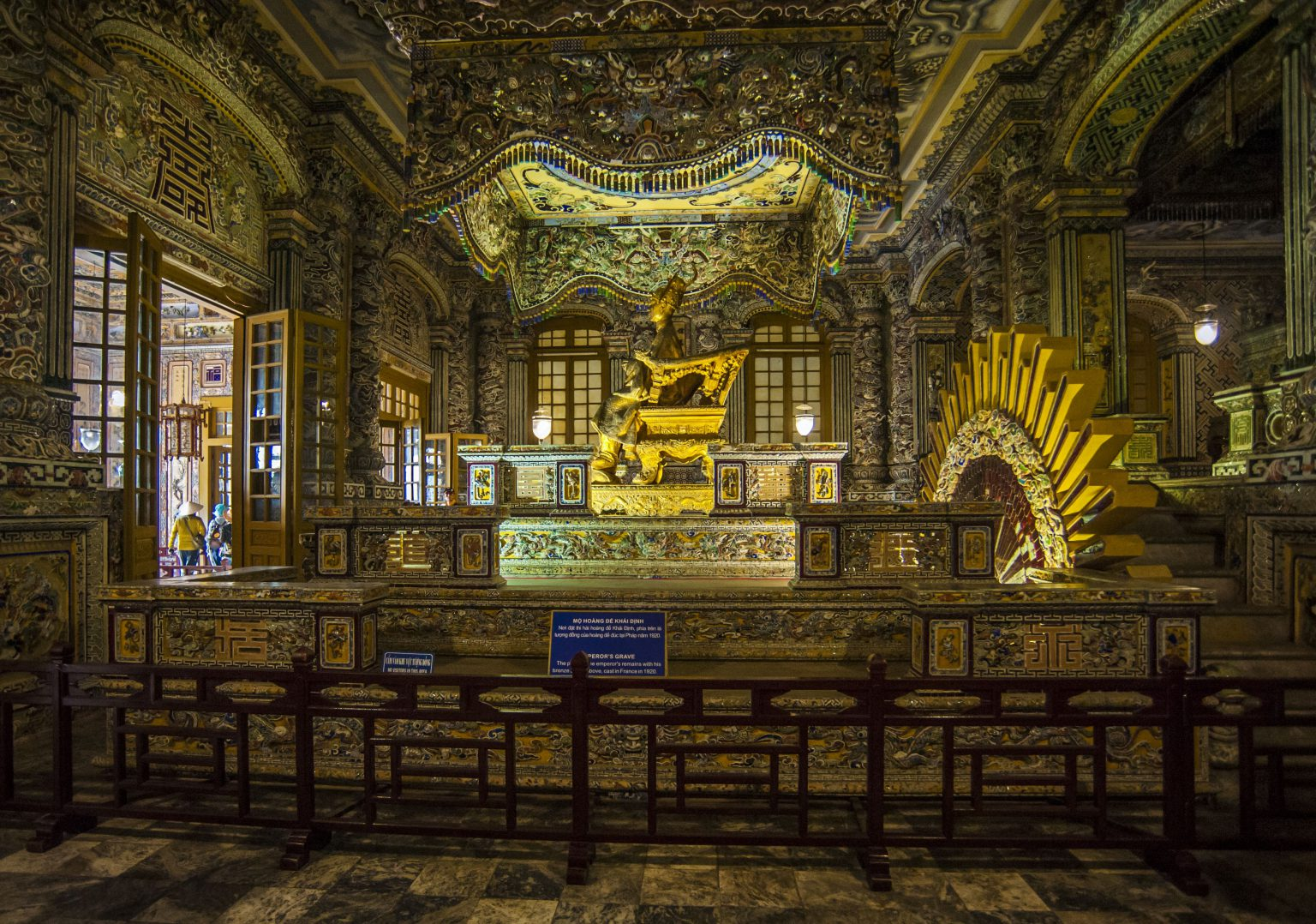
Decorative Mosaic Art in Khai Dinh Mausoleum
The scientist Le Quy Don wrote about Thuan Hoa, which is now the city of Hue, in his work "Phu Bien Magazine" in 1776. He said that the walls of the outer walls were all made many yards thick, with lime and porcelain pieces to make dragons, phoenixes, lions, tigers, and flower grass. The Nguyen lords' era was characterized by mosaic art like that. The art of adorning porcelain objects was widely adopted by the Nguyen kings. The decoration of green enamel porcelain pieces in the form of dragons (dragon heads, horse bodies) on the screen may be seen directly in the Tu Duc mausoleum.
 Perhaps the Khai Dinh mausoleum's inner construction represents the height of mosaic art. King Khai Dinh took control of the mausoleum's construction in 1920 while he was still alive. The mausoleum is located around 8 kilometers south of the nation's capital. To construct the mausoleum, King Khai Dinh organized competent domestic laborers. In addition to the stunning Vietnamese porcelain, he imported cement, iron, steel, tile, and porcelain from France as well as colorful glass from China and Japan. Therefore, it will take 11 years to finish the mausoleum, which is magnificent and elaborate.
Perhaps the Khai Dinh mausoleum's inner construction represents the height of mosaic art. King Khai Dinh took control of the mausoleum's construction in 1920 while he was still alive. The mausoleum is located around 8 kilometers south of the nation's capital. To construct the mausoleum, King Khai Dinh organized competent domestic laborers. In addition to the stunning Vietnamese porcelain, he imported cement, iron, steel, tile, and porcelain from France as well as colorful glass from China and Japan. Therefore, it will take 11 years to finish the mausoleum, which is magnificent and elaborate.
The interior of Thien Dinh Palace, which houses the Khai Thanh Palace, the king's tomb, and a monument of the monarch, is decorated with mosaic art. Hundreds of mosaics made out of porcelain and colored glass that are embellished on the walls, columns, and altar cells showcase mosaic art.
The dragon, the representation of the king's "dragon destiny," is the most significant decorative motif. Both a straight and an angled perspective of a dragon are shown. Big eyes, lion-like noses, two pointed horns, a mane, ears, a long beard, five claws, a meandering body, and a large open mouth that can contain pearls or swastikas are all characteristics of dragons. These two "Long Ngư hý thủy" paintings are wonderfully painted on the altar. The altar is possibly the most lovely location to display the dragon image. There are numerous Swastika motifs that have positive connotations and represent the Buddha. There are also a lot of porcelain mosaics used to decorate plants and flowers. The multicolored porcelain pieces that are inlaid were all acquired from various sources by breaking the jar to obtain the piece. How to neatly embellish each cell, square, or rectangle in a molded artwork. The paintings have a tight texture. The pieces of multicolored porcelain still have their original hue and exhibit brilliance, are slightly colorful, and are exquisitely detailed, befitting the position of a king of the Nguyen Dynasty. The Nguyen King who is most attractive is this. The dragon and swastika images on the altar were made by artisans in an apparent attempt to grant King Khai Dinh a happy afterlife in the Buddhist world.
 The Main Impregnation area, where the King's Tomb is located below, is another decorative highlight. In this location, there is a statue of the King and a canopy (bửu tán) built of concrete, iron, and steel, yet its lines are very soft and delicate. The mosaics made of porcelain and glass are arranged in umbrella- and compartment-like patterns on the pedestal of the statue. The topic continues to be dragons, swastikas, and flowers. A dragon-like figure holding phrases can be seen on the ceiling. Its four corners each have an image of a bat, suggesting blessings for the monarch (the Vietnamese term for the bat, Biên Phúc, sounds the same as the English Blessed is good). When five bats are decorated, it might be seen as "Ngũ phúc lâm môn" coming together. There are rows of columns with dragons adorning their bodies in The Main Impregnation. The Buddha's emblem is inlaid with blue glass, and there are hundreds of swastikas that have been simplified throughout Hậu Tẩm.
The Main Impregnation area, where the King's Tomb is located below, is another decorative highlight. In this location, there is a statue of the King and a canopy (bửu tán) built of concrete, iron, and steel, yet its lines are very soft and delicate. The mosaics made of porcelain and glass are arranged in umbrella- and compartment-like patterns on the pedestal of the statue. The topic continues to be dragons, swastikas, and flowers. A dragon-like figure holding phrases can be seen on the ceiling. Its four corners each have an image of a bat, suggesting blessings for the monarch (the Vietnamese term for the bat, Biên Phúc, sounds the same as the English Blessed is good). When five bats are decorated, it might be seen as "Ngũ phúc lâm môn" coming together. There are rows of columns with dragons adorning their bodies in The Main Impregnation. The Buddha's emblem is inlaid with blue glass, and there are hundreds of swastikas that have been simplified throughout Hậu Tẩm.
 There are magnificent mosaics depicting phoenixes, tigers, deer, sparrows, peacocks, roosters, cranes, ducks, rabbits, and floral grass on the walls of the mausoleum. Most commonly found in Vietnamese villages, many animals live in close proximity to people and their ideal lifestyles. The four-season picture depicts the typical flower for each season: pine, bamboo, chrysanthemum, and apricot. The lotus bloom can also represent a particular season of the year on occasion. The Five Blessings are symbolized, in particular, by the picture of five bats flying across the clouds. In some paintings, the letters Phuc and Tho are depicted as large letters.
There are magnificent mosaics depicting phoenixes, tigers, deer, sparrows, peacocks, roosters, cranes, ducks, rabbits, and floral grass on the walls of the mausoleum. Most commonly found in Vietnamese villages, many animals live in close proximity to people and their ideal lifestyles. The four-season picture depicts the typical flower for each season: pine, bamboo, chrysanthemum, and apricot. The lotus bloom can also represent a particular season of the year on occasion. The Five Blessings are symbolized, in particular, by the picture of five bats flying across the clouds. In some paintings, the letters Phuc and Tho are depicted as large letters.
Porcelain, glass, and stone mosaics are a type of decoration that incorporates many traditional cultural elements that are expressed in themes that were prevalent in Vietnamese society at the time. These decorations are quite similar to folk paintings in terms of themes and the art of selecting occasionally vibrant colors.
The mausoleum's exquisite beauty showcases the peak of modern mosaic art and the creativity of artisans and craftsmen from the convergent regions. The importance of cultural and national heritages is buried deep within the scope of the contest's theme.
Source: Prof. Trinh Sinh